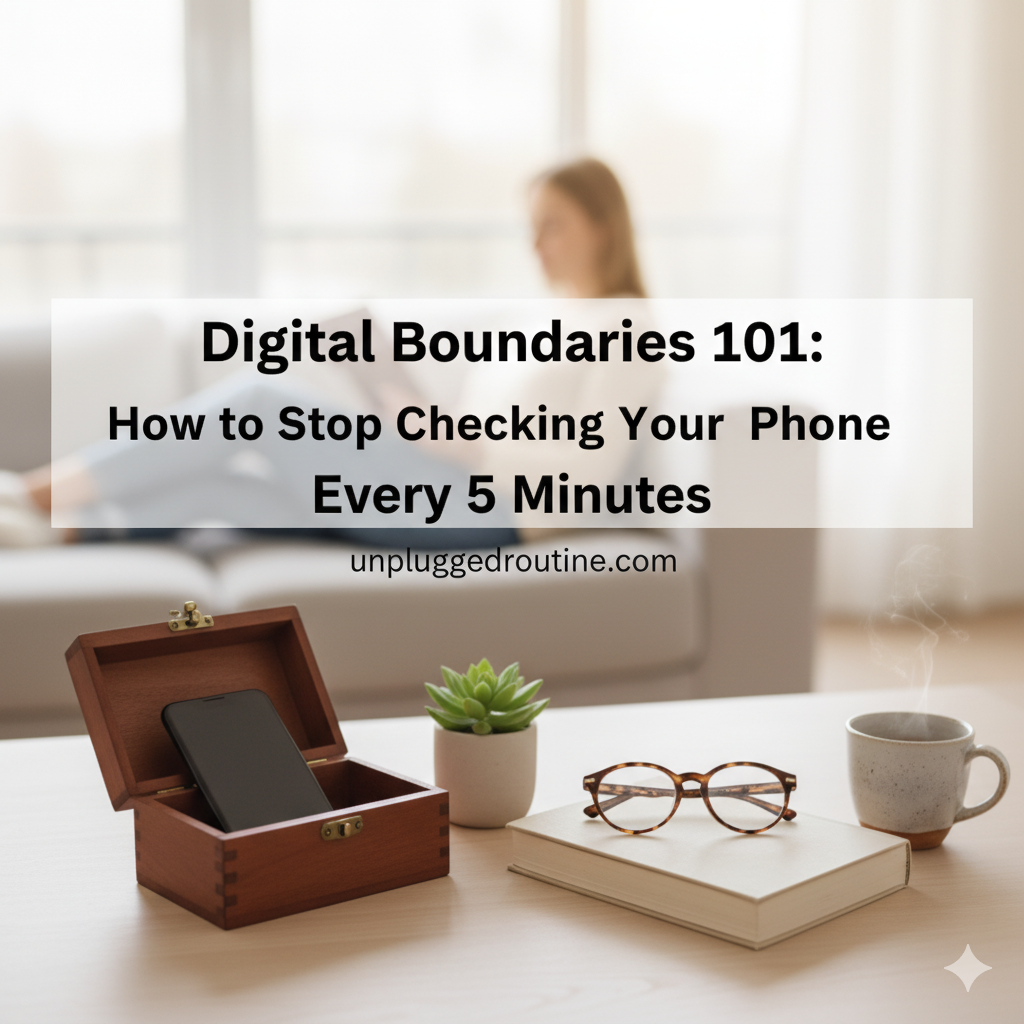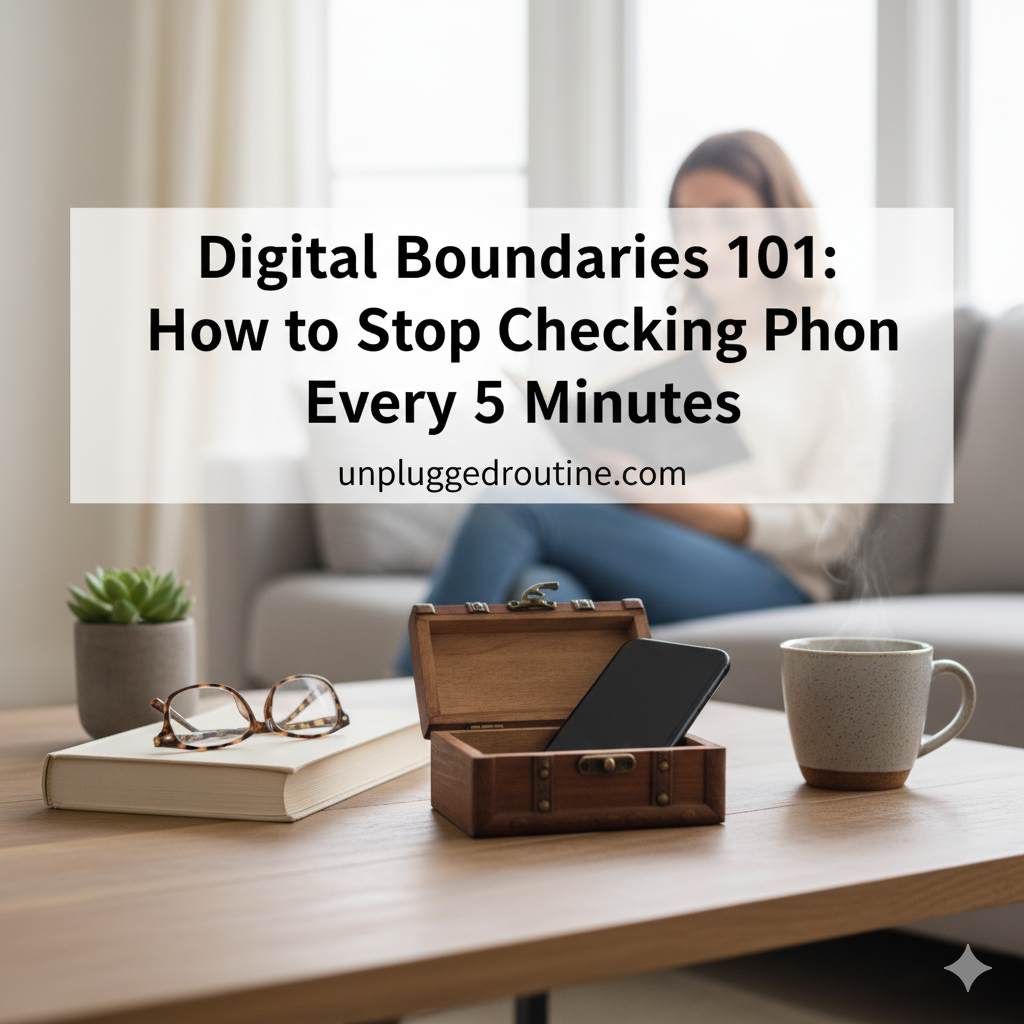Do you ever feel like your phone has an invisible string attached to your hand, constantly tugging you back? That irresistible urge to pick it up, unlock it, and scroll, even when you know you should be doing something else? You’re not alone. In our hyper-connected world, the “check habit” has become a pervasive issue, draining our focus, stealing our time, and often leaving us feeling more anxious than informed.
But what if you could break free? What if you could regain control, setting healthy digital boundaries that empower you rather than restrict you? This isn’t about ditching your phone entirely; it’s about mastering your relationship with it. And it starts with understanding why we check, and how we can consciously choose to stop.

The Pavlovian Ping: Why We Can’t Resist the Screen
Before we dive into solutions, let’s understand the enemy: the psychology behind the incessant phone checking. It’s not a lack of willpower; it’s a deeply ingrained habit, reinforced by sophisticated design.
- The Dopamine Loop: Every notification, every new like, every message gives us a tiny hit of dopamine – the brain’s “reward” chemical. Our brains quickly learn to associate checking the phone with this pleasurable sensation, creating a powerful feedback loop.
- Fear of Missing Out (FOMO): We worry that if we don’t check, we’ll miss something important, a social invitation, breaking news, or a crucial update. This anxiety drives us back to the screen again and again.
- Social Validation: Social media, in particular, taps into our need for connection and validation. Likes, comments, and shares make us feel seen and appreciated, fueling the desire to constantly check for more.
- The “Pocket Buzz” Syndrome: Even when our phones aren’t vibrating, many of us experience phantom vibrations, an indication of just how attuned our brains are to the expectation of a notification.
- Habitual Idleness: When we have a moment of downtime – waiting in line, sitting on the couch, even during a conversation lull – our default action has become reaching for the phone, filling the void with digital noise.
Recognizing these triggers is the first crucial step. It’s not about being weak; it’s about being human in a digitally engineered environment.
Your 7-Step Blueprint to Breaking the “Check Habit”
Ready to reclaim your attention and time? Here’s your actionable blueprint to stopping the compulsive phone checking. This isn’t a quick fix, but a series of sustainable practices that will gradually re-wire your habits.
Step 1: The Awareness Audit – Log Your Usage (1 Day)
You can’t change what you don’t measure. For one full day, consciously track every time you pick up your phone. You don’t need a fancy app; a simple tally mark on a piece of paper or a note on your phone (if you can resist getting sidetracked!) will do.
The Goal: To become acutely aware of how often you check, when you check, and why. Are you checking out of boredom? Anxiety? Habit? This awareness is incredibly powerful. Most people are genuinely shocked by their real usage.
Step 2: The Physical Barrier – Create “No-Phone Zones”
Make certain areas of your life sacred and phone-free. This creates intentional friction, making it harder to mindlessly pick up your device.
- The Bedroom: This is paramount. Your phone does not belong next to your bed. Get an old-fashioned alarm clock. Charge your phone in another room overnight. This dramatically improves sleep and reduces the first-thing-in-the-morning scroll.
- The Dinner Table: Family meals should be a time for connection, not distraction. Designate the dinner table a phone-free zone for everyone.
- The Bathroom: This might seem minor, but it’s a common place for mindless scrolling. Keep your phone out.
- Social Gatherings: When out with friends or family, commit to putting your phone away. If you need to check something, excuse yourself.
Step 3: The Time Block Tactic – Schedule Phone-Checking Times
Instead of checking your phone reactively, create proactive “phone check” slots in your day. Treat it like any other appointment.
- For example: 9 AM, 1 PM, 5 PM. Outside of these times, your phone is on silent, face down, or put away.
- Start with just a few scheduled checks, then gradually reduce them as you get more comfortable.
- This removes the impulsive “every 5 minutes” checking and replaces it with intentional, focused engagement.
Step 4: The Digital Declutter – Remove Temptations
Just like you’d declutter a messy room, declutter your digital environment.
- Delete Unused Apps: Get rid of any apps you rarely use but that still tempt you with notifications or endless content.
- Hide Social Media & Entertainment Apps: Move your most addictive apps off your home screen and into a folder on a secondary screen. The extra steps required to open them can be enough to break the impulsive habit.
- Turn Off Non-Essential Notifications (Revisit your Notification Mastery!): Building on our previous post, ensure only critical apps can notify you. Fewer pings mean fewer reasons to check.
Step 5: The Friction Creator – Add Small Obstacles
Make it slightly harder to access your phone or its most addictive features.
- Gray Scale Mode: Many phones allow you to switch to grayscale. Without vibrant colors, apps are far less engaging and addictive. Try it for a few hours or even a full day.
- Different Passcode: Change your easy-to-remember PIN to a slightly more complex one (even just adding one extra digit). That tiny bit of cognitive load can interrupt the mindless grab-and-unlock routine.
- Out of Sight, Out of Mind: When you’re working or focusing, put your phone in a drawer, in another room, or even just face down across the room. The physical distance creates a barrier.
Step 6: The Replacement Strategy – Find Healthy Alternatives
The “check habit” often fills a void – boredom, anxiety, moments of transition. Instead of reaching for your phone, have a go-to alternative ready.
- Keep a Book Handy: Always have a physical book or e-reader nearby.
- Take a Micro-Break: Stand up, stretch, look out the window, grab a glass of water.
- Engage with Your Environment: Notice the details around you, observe people, practice mindfulness.
- Connect with a Person: If you’re with someone, strike up a conversation.
- Journal: Carry a small notebook to jot down thoughts or ideas.
Step 7: The Self-Compassion Clause – Be Patient and Forgive Yourself
Breaking a deeply ingrained habit takes time and effort. There will be slip-ups. You’ll catch yourself mindlessly scrolling. That’s okay!
- Don’t Beat Yourself Up: Acknowledge it, gently redirect, and recommit to your boundaries. Shame is counterproductive.
- Celebrate Small Wins: Notice when you don’t check your phone in a moment of boredom. Celebrate that small victory!
- Iterate and Adjust: What works for one person might not work for another. Experiment with these steps, find what resonates with you, and adjust as needed.
Visualizing Your Freedom
Imagine being able to sit quietly, letting your thoughts drift, without the immediate urge to fill the silence with a screen. Imagine having a conversation where you’re truly present, making eye contact, and listening intently. Imagine dedicating hours to a creative project or a beloved hobby, uninterrupted by the incessant demands of your device. This isn’t just about reducing phone use; it’s about expanding your capacity for connection, creativity, and calm.

Conclusion: Reclaim Your Time, Reclaim Your Life
Breaking the habit of constantly checking your phone isn’t easy, but it is incredibly rewarding. By setting clear digital boundaries, understanding your triggers, and implementing these actionable steps, you’re not just reducing screen time; you’re reclaiming your focus, enhancing your relationships, improving your sleep, and creating more space for what truly matters in your life.
Your phone is a tool, and like any tool, it should serve you, not control you. It’s time to put yourself back in the driver’s seat.
Which of these 7 steps will you implement first to stop checking your phone every 5 minutes? Share your commitment in the comments below! And for more insights and tools to foster a balanced life, make sure to visit unpluggedroutine.com.